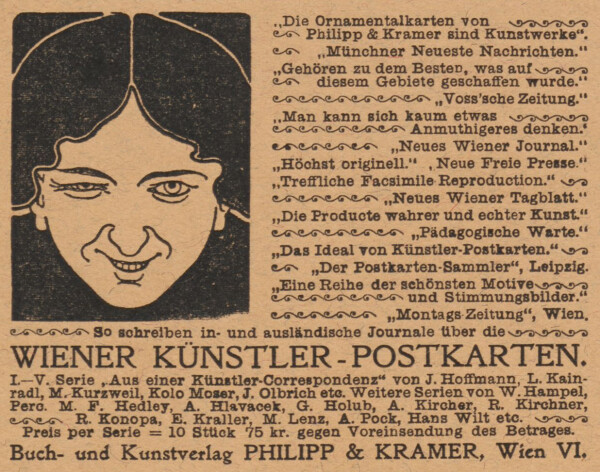Siebener-Club

Advertisement for Viennese artists' postcards, book and art publisher Philipp & Kramer, in: Vereinigung bildender Künstler Österreichs Secession (Hg.): Ver Sacrum. Organ der Vereinigung bildender Künstler Österreichs, 1. Jg., Heft 8 (1898).
© ANNO | Austrian National Library
The members of the Siebener-Club surrounding Josef Hoffmann, Joseph Maria Olbrich and Koloman Moser met regularly in the early 1890s to exchange artistic ideas. The association is considered the original nucleus of the Vienna Secession and the Hagenbund.
The Viennese art scene in the 1890s comprised several artists’ associations and loosely associated groups, such as the Hagen Society. Probably around 1890, at the latest in 1892, the Siebener-Club [“Club of Seven”] was formed. The name derived from its seven founding members: Josef Hoffmann, Joseph Maria Olbrich, Koloman Moser, Joseph Urban, Adolf Karpellus, Leo Kainradl and Ludwig Koch. The informal group of young artists met regularly at a bar called Zum blauen Freihaus, run by the art lover Joseph Calasan Haagen, at Adolf Kratochwilla’s Café Sperl next door or at the restaurant Zum goldenen Kegel.
Several members of the Siebener-Club also joined the Cooperative of Visual Artists in Vienna and participated in its famous costume parties as a collective. On 4 March 1895, for instance, a group of 46 people, including Max Fabiani and Otto Wagner, participated in the celebration “Fin de siècle” under the motto “Pegasus brothers at the aluminum brewery.” The official ball souvenir was the exhibition catalogue Secession der Wilden und Freie Vereinigung der Zahmen [“Secession of the Wild and Free Association of the Tame”], a satirical reference to the Munich Secession and the Free Association of Düsseldorf Artists, which had been held at the Künstlerhaus in 1894. Moser, Koch and Eugen von Blaas created illustrations for the catalogue, which they signed with their names and the collective abbreviation “C7.” By putting this signet next to their name or monogram, the artists revealed their membership in the club.
The following year, the group that attended the “Hubertusfest” on 17 February 1896 comprised 36 people, including Moser’s sisters Charlotte and Leopoldine and Adolf Kratochwilla, the owner of the Café Sperl. The Wiener Journal reported:
“The ‘Siebener-Club,’ a social club of painters, architects and sculptors, was in charge of the artistic decoration of the middle axis of the Künstlerhaus – five rooms in an organic outline.”
The artists again created drawings for the ball souvenir, this time a hunting-themed book titled Waidmannsheil. Teutscher Lehrprinz des edlen Waidwerks.
Further illustrations were published in 1896 in the collection Aus der Mappe des Siebener-Club, a supplement in the second year of the magazine Der Architekt. Hans Fraungruber was among the guests of the Siebener-Club and published the magazine Für die Jugend des Volkes on behalf of the Vienna teachers’ association Wiener Lehrerverein as well as the series Thierfreundliche Jugend, which was illustrated by C7 members from 1895. Fraungruber also received several correspondence cards of the Siebener-Club, whose members wrote frequently to each other, usually decorating their cards with drawings. In this context, Moser, in particular, anticipated formal and compositional design elements that would resurface in the magazine Ver Sacrum. Some of these drawings were published by Philipp & Kramer in 1897 as Serie I-V Aus einer Künstler-Correspondenz in the series Wiener Künstler-Postkarten.
The Siebener-Club was more than merely a social club for artists, it was a group whose members presented themselves confidently on the Viennese art scene. Some members joined the Cooperative of Visual Artists in Vienna around 1896 and formed the original nucleus of Viennese Modernism together with artists such as Gustav Klimt, Carl Moll, Joseph Maria Olbrich, Otto Wagner and members of the Hagen Society. They played a vital part in the reform of art and in the founding of the new artists’ associations Association of Austrian Artists Secession (1897) and Hagenbund (1899). The dissolution of the Siebener-Club was announced retrospectively by Moser in the Wiener Zeitung on 29 May 1900:
“The undersigned, as last president, hereby announces that the association ‘Siebener Club’ was dissolved in November 1896. Koloman Moser.”
Literature and sources
- N. N.: Ballchronik. Weidmannsheil! Das Hubertusfest der Wiener Künstlergenossenschaft, in: Neues Wiener Journal, 18.02.1896, S. 7-8.
- Wiener Zeitung, 29.05.1900, S. 16.
- Hans Ankwicz von Kleehoven: Die Anfänge der Wiener Secession, in: Alte und moderne Kunst. Österreichische Zeitschrift für Kunst, Kunsthandwerk und Wohnkultur, 5. Jg., Heft 6-7 (1960), S. 6-10.
- Marian Bisanz-Prakken: Tendenzen der Neunziger Jahre bis zur Gründung der Secession, in: Marian Bisanz-Prakken (Hg.): Heiliger Frühling. Gustav Klimt und die Anfänge der Wiener Secession 1895–1905, Ausst.-Kat., Albertina (Vienna), 16.10.1998–10.01.1999, Vienna 1999, S. 59-71.
- Gerd Pichler: Der Siebener-Club, in: Rudolf Leopold, Gerd Pichler (Hg.): Koloman Moser 1868−1918, Ausst.-Kat., Leopold Museum (Vienna), 25.05.2007–10.09.2007, Munich 2007, S. 38-47.

